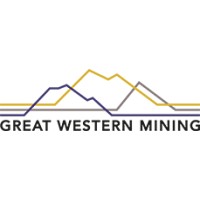Great Western Mining Corporation Plc (LON:GWMO) has announced assay results from a reconnaissance sampling programme targeting tungsten mineralisation at and around the Pine Crow and Defender tungsten workings where it has recently expanded its acreage. The detailed results are set out in table 1 below.
HIGHLIGHTS
· The previously producing Pine Crow and Defender tungsten mines lie on Great Western’s claims. In late 2024 the Company increased its claims around these two former mine sites.
· Multiple selective grab samples recently taken have recorded over 1% WO3 (tungsten trioxide), with maximum of 1.75% WO3.
· The assay results significantly upgrade the tungsten potential around and between the workings where the previous highest recorded sample was 0.33% WO3.
· The trend between Pine Crow and Defender covers 1.2 km.
· Potential for significant upgrade between the two workings with use of modern technology.
Given the high tungsten contents from the grab samples, the Company will now fast-track further exploration on these claims, located approximately 45 km from the Pilot Mountain tungsten project operated by Guardian Metal Resources, which has a JORC-compliant resource of 12.53Mt grading 0.27% WO3. The next phase will entail mapping and soil sampling together with geophysical surveys, including gravity, and trenching.
Spot tungsten prices (ammonium paratungstate, APT) have recently hit 12-year highs of approximately $400/mtu, driven by Chinese restrictions on critical mineral exports. China controls 80% of global tungsten production and 97% of global processing capabilities. Tungsten has now been officially declared a critical mineral in the USA.
Great Western Mining Chairman Brian Hall commented: “It is still early days, but these initial results generated by our exploration team are extremely encouraging and a strong case can be made for establishing a single body of mineralisation joining Pine Crow and Defender across a 1.2 km tract.
“Together with our Huntoon copper porphyry setting which we will be drilling this summer, Great Western is now working directly on two metals which are formally on the critical list. In the case of tungsten, we are only too aware that globally there are very few listed companies which offer investors exposure to this high priority defence and industrial metal, and we will be working towards launching a drill campaign.”
BACKGROUND
The Defender and Pine Crow tungsten workings were identified as priority targets based on the evidence of legacy tungsten production. Situated at each end of a 1.2 km trend which begins approximately 2 km northeast of and on trend with the Company’s skarn copper resource at M2, part of the Company’s Huntoon Copper Project. Recent field work has confirmed the presence of scheelite-bearing skarns and returned very encouraging assay results which underscore the potential for high-grade tungsten mineralisation coupling both prospects.
New claims were staked in late 2024, and a field visit made in April 2025 by company staff and consultant Dr. Lawrence Carter. The Defender and Pine Crow mine workings and dumps were examined and selective grab samples collected. Sampling was guided by use of a UV lamp to identify scheelite (CaWO4) and powellite (CaMoO₄), both of which fluoresce under UV.

Figure 1. Left, sample fluorescing under UV lamp in field. Right, main Defender workings, with old loading platform.
Assay results from this work have returned grades of up to 1.75% WO3, representing a substantial increase on the highest tungsten value previously recorded from these prospects in the Company’s database (0.33 % WO3)[1]. These results are highly encouraging and further reinforce the tungsten prospectivity of the district. The samples also returned anomalous grades for a range of other metals, including silver, bismuth, copper, indium, molybdenum, tin and zinc (Table 1).
The grab samples reported here are selective and not necessarily representative of wider mineralised zones, but the mineralisation observed strongly supports the next phase of work, including channel sampling and geophysical surveys.
RESULTS IN DETAIL
Table 1. Selected elemental abundances from new rock chip samples at Defender and Pine Crow workings. Values in bold are anomalous. Values in bold & red are strongly anomalous.
| Sample ID | Ag (ppm) | Bi (ppm) | Cu (ppm) | In (ppm) | Mo (ppm) | Sn (ppm) | Zn (ppm) | WO3 (%) |
| LC-GWDF-01 | 0.09 | 0.37 | 62.1 | 1.68 | 181.5 | 32.5 | 115 | 0.4* |
| LC-GWDF-02 | 3.07 | 1.11 | 2540 | 1.67 | 26.9 | 31.5 | 229 | 0.11† |
| LC-GWDF-03 | 0.55 | 7.03 | 19.3 | 1.54 | 644 | 109.5 | 180 | 1.5* |
| LC-GWDF-04 | 0.13 | 3.69 | 21.5 | 2.3 | 878 | 159 | 356 | 1.75* |
| LC-GWDF-05 | 0.06 | 0.48 | 3.2 | 1.19 | 80.5 | 36.9 | 202 | 0.11† |
| LC-GWDF-06 | 0.05 | 0.32 | 2.7 | 2.08 | 108 | 28.8 | 161 | 0.54* |
| LC-GWDF-07 | 0.08 | 0.36 | 7.5 | 1.65 | 175 | 42.9 | 253 | 0.46* |
| LC-GWDF-08 | 0.09 | 1.3 | 33.7 | 1.9 | 81.7 | 59.2 | 252 | 0.28* |
| LC-GWPC-01 | 0.23 | 35.1 | 15 | 7.72 | 729 | 196.5 | 175 | 1.2* |
| LC-GWPC-02 | 0.06 | 0.3 | 5.7 | 1.85 | 3.52 | 0.9 | 6 | 0.005† |
| LC-GWPC-03 | 1.07 | 33.1 | 417 | 0.01 | 229 | 21.1 | 365 | 0.36* |
| LC-GWPC-04 | 6.55 | 15.5 | 756 | 0.56 | 24.1 | 21.3 | 160 | 0.04† |
| LC-GWPC-05 | 4.46 | 0.51 | 12.8 | 1.16 | 31.5 | 2.8 | 1070 | 0.01† |
* WO3 analysis via XRF
† W analysis via ICP-MS, converted to WO3 via stoichiometric calculation, see notes under ‘Additional Information’.
Previous sampling by the Company at these prospects returned best grades of 0.33% WO3 (Pine Crow)1 and 0.20% WO3 (Defender)1. These new results, which were better targeted through in-field use of a UV lamp and the use of a more favourable analytical technique for high grade tungsten at the laboratory (see notes below), represent significant upgrades to both the exploration methodology and prospectivity, highlighting the polymetallic potential at these prospects.

Figure 2. Map showing northern end of GWM’s Black Mountains claim group, with new grab samples from Pine Crow and Defender workings indicated.
ADDITIONAL INFORMATION
All samples were initially analysed for a broad suite of elements using ICP-MS following a four-acid digestion at ALS laboratories in Reno. Where tungsten values exceeded 1,500 ppm W, corresponding samples were subsequently re-analysed by X-ray fluorescence (XRF) using fused-bead preparation, which reports results as WO3 (tungsten trioxide) rather than W (elemental tungsten). All results from ICP-MS analyses have been converted from ppm W to % WO₃ using a standard stoichiometric factor (0.0001261) to facilitate comparison. XRF results consistently returned higher WO₃ values than those calculated from ICP-MS results for the same samples, which may reflect more complete recovery of refractory tungsten phases during fusion. Readers are advised to treat this conversion as indicative only. Standard QC procedures were followed.






































